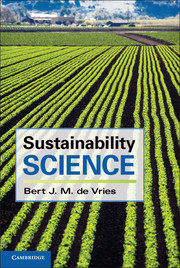Book contents
- Frontmatter
- Contents
- Preface
- 1 Introduction
- 2 The System Dynamics Perspective
- 3 In Search of Sustainability: Past Civilisations
- 4 The World in the Past 300 Years: The Great Acceleration
- 5 Sustainability: Concerns, Definitions, Indicators
- 6 Quality of Life: On Values, Knowledge and Worldviews
- 7 Energy Fundamentals
- 8 On Knowledge and Models
- 9 Land and Nature
- 10 Human Populations and Human Behaviour
- 11 Agro-Food Systems
- 12 Renewable Resources: Water, Fish and Forest
- 13 Non-Renewable Resources: The Industrial Economy
- 14 Towards a Sustainable Economy?
- 15 Outlook on Futures
- Glossary
- References
- Index
- Plate Section
- References
11 - Agro-Food Systems
Published online by Cambridge University Press: 05 January 2013
- Frontmatter
- Contents
- Preface
- 1 Introduction
- 2 The System Dynamics Perspective
- 3 In Search of Sustainability: Past Civilisations
- 4 The World in the Past 300 Years: The Great Acceleration
- 5 Sustainability: Concerns, Definitions, Indicators
- 6 Quality of Life: On Values, Knowledge and Worldviews
- 7 Energy Fundamentals
- 8 On Knowledge and Models
- 9 Land and Nature
- 10 Human Populations and Human Behaviour
- 11 Agro-Food Systems
- 12 Renewable Resources: Water, Fish and Forest
- 13 Non-Renewable Resources: The Industrial Economy
- 14 Towards a Sustainable Economy?
- 15 Outlook on Futures
- Glossary
- References
- Index
- Plate Section
- References
Summary
Introduction: The Human Habitat
The topic of a previous chapter is ‘pristine’ nature, but pristine nature is becoming scarce. Human populations have been very successful as a species and now have impact upon one-third or more of the biosphere. Humans have always interfered with the natural environment: Agriculture and pastoralism are sustained forms of manipulation of plants and animals. During the process of agrarianisation, they have learned to exploit soils, fish and forests for the provision of food, fiber and fuel. The larger part of the world population is still engaged in agriculture, and food production is still the most direct and largest interface between humans and nature. In monetary terms, agricultural products make up only a few percent of gross world product (GWP), partly because subsistence agriculture is outside conventional economic statistics. If food processing, transporting and retailing are considered, the economic role is much larger and in the order of 8 percent. But in physical terms, agriculture and the larger food system are of enormous importance. This chapter explores sustainability issues in present-day agricultural populations and systems. Agriculture is understood here in the broad sense of agroecology and the agro-food systems in the world, from local production to global trading and processing. It connects the Latin words colere and ager, the latter meaning field.
There are many ways in which human populations interfere with the ‘natural’ world of biogeochemical cycles and ecosystems. Although one can discern some universal tendencies in human-environment interactions, farming and animal husbandry are intrinsically local and the natural cycles still dictate the human activities in space and time. Land is locality par excellence. It is only logical, then, to focus first on the human habitat. The relevant branch of science is geography, along with ecology a core discipline in sustainability science.
- Type
- Chapter
- Information
- Sustainability Science , pp. 339 - 378Publisher: Cambridge University PressPrint publication year: 2012



